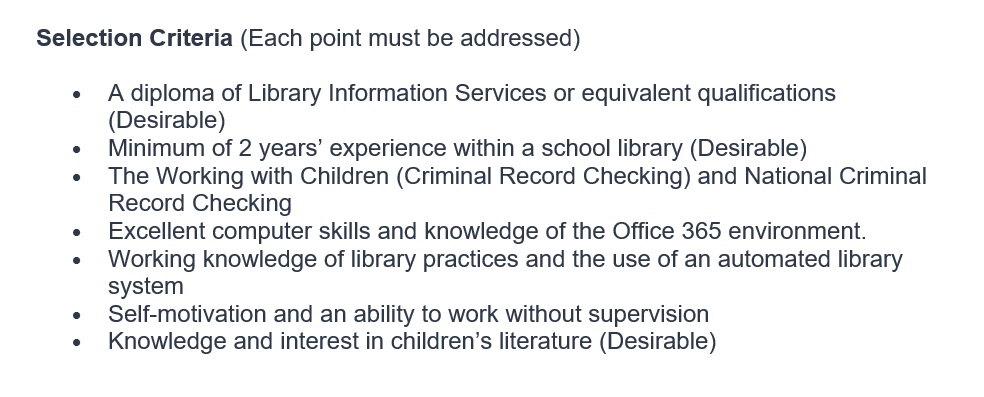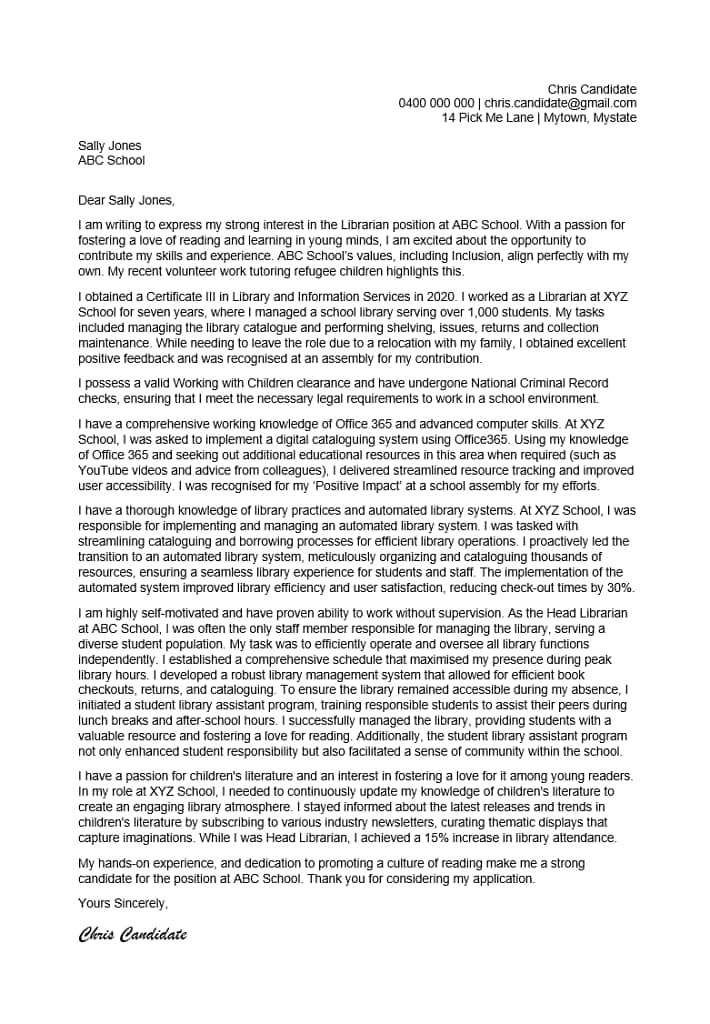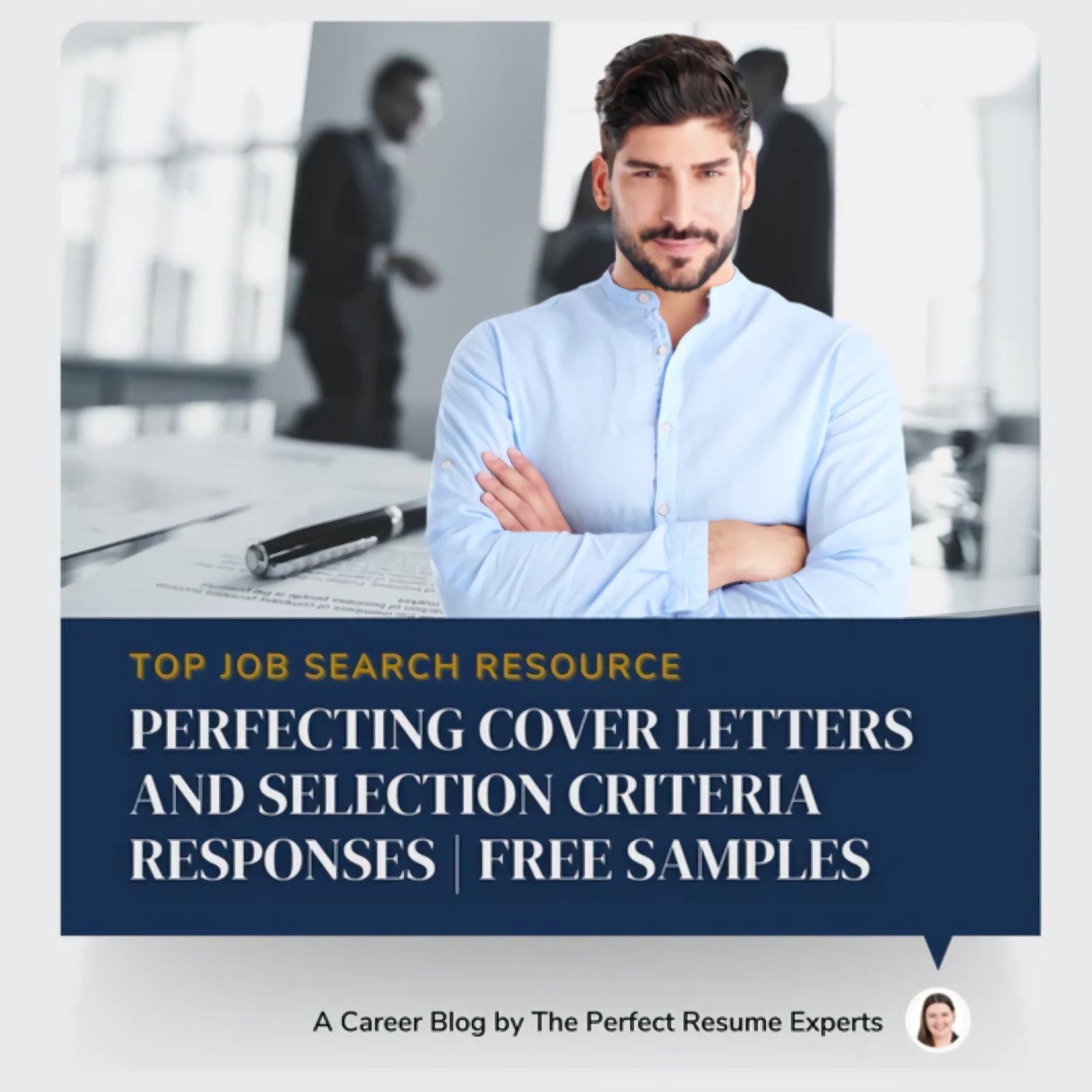

How to Write a Cover Letter Addressing Selection Criteria in 10 Steps

Written by Nicole Wren

#ezw_tco-9 .ez-toc-title{ font-size: 120%; font-weight: 500; color: #000; } #ezw_tco-9 .ez-toc-widget-container ul.ez-toc-list li.active{ background-color: #ededed; } Table of Contents Toggle Table of Content Toggle
by Nicole Wren | Jan 29, 2024 | Writing Advice
Some job applications will ask you to provide a response to selection criteria , as well as your resume or CV. These criteria are the specific skills and experience that a job requires. In many cases, the application guidelines request that the selection criteria should be responded to within a cover letter. (Sometimes, they request a response in a different format, like this APS Statement of Claims example ). Many people wonder how to write a cover letter addressing selection criteria, though (as selection criteria writers , we get asked daily!).
While your resume or CV should state that you have the relevant experience, a selection criteria response will require more detail and specific examples. As well as providing more information, selection criteria also provide a structured way to assess candidates.
The job ad might include something like this:

Let’s look at 10 things to keep in mind when addressing selection criteria in a cover letter.
1. Start Your Cover Letter in the Standard Cover Letter Format
Begin your cover letter in the standard format, with a header containing your contact information. Then, include the employer’s contact details, including their name (or a generic salutation like “Dear Hiring Manager”). Use a standard font and font size, like Arial 10-12.

2. (Opening Paragraph): Express Your Enthusiasm
Specifically state the role you are applying for. Convey your eagerness to contribute your skills and experience to the organisation. You might also like to mention the company’s values, and how your own align (tip: be specific and authentic here). If there is something else that attracts you to the organisation (such as a recent company achievement), you might like to mention it here, to show you have a good understanding of them.

3. (Body Paragraphs): List and Highlight Each Selection Criteria
List and highlight each of the selection criteria in the body of the cover letter. This will help you keep on task and ensure each selection criterion is adequately responded to (note: you should remove this at the end – see step 9).

4. (Body Paragraphs): Paraphrase Each Criterion and Your Experience
Write an introductory sentence for each criterion, paraphrasing the language and keywords used in the selection criterion.

5. (Body Paragraphs): Brainstorm Ideas for Each Criterion
Make some notes within your document, then choose your ‘best ideas’. Tip: you’ll need to be as specific as possible. Rather than saying you communicated daily with different customers in a previous role, think of a specific time you communicated with a specific customer, and how you had a positive impact.
6. (Body Paragraphs): Use the STAR Format for Each Example
The STAR format is a well-known way to structure selection criteria. It goes like this:
Situation (S): Briefly set the context by describing the situation or problem you encountered. Keep it concise to provide necessary background information. This section should make up approximately 10% of your response.
Task (T): Describe your specific role or task within the situation. Explain what was expected of you and any challenges or goals you needed to address. This section should make up around 10% of your response.
Action (A): This section should make up around 60% of your response. Describe the actions you took in detail. This is where you showcase your skills, competencies, and problem-solving abilities. Use specific examples, highlight your contributions, and explain your thought process.
Result (R): Approximately 20% of your response. Conclude by outlining the positive outcome or result of your actions. Mention any benefits to the organisation. While this is one of the smaller sections, it is one of the most important. Many candidates forget to include a strong result section.
Note, the STAR method is not necessary for yes/no criteria such as certain qualifications. For these criteria, you can simply state that you have the required qualifications.

7. (Conclusion Paragraph): Sign-off Positively
Conclude your cover letter with a short paragraph thanking the reader for their time, and welcoming the opportunity for an interview. You may like to reiterate your interest in the role.

8. Sign Off as in a Standard Cover Letter
End with a professional sign-off such as ‘Kind regards’ or ‘Yours Sincerely’, along with your full name. There is no need to sign the cover letter.

9. Remove the Highlighted Selection Criteria
Since these headings were included only as a guide for you, you should now remove them. Your introductory sentence within each paragraph will be enough to allow the reader to understand that you have addressed each one.
10. Proof-Read and Submit
Proof-read your document for any errors, including grammar and spelling. You may like to have a friend or family member complete this part for you. Another tip is to save the document as a PDF, and read through it that way (the doucmnet will look slightly different and will allow you to assess it with fresh eyes).
Cover Letter Addressing Selection Criteria Example

Frequently Asked Questions
Can you address selection criteria in a cover letter.
There are a few different formats for responding to selection criteria. Sometimes, you may be asked to respond to specific online questions related to the criteria. Sometimes, you may be asked to provide a ‘separate document’ style selection criteria response. Sometimes, you can address selection criteria in a cover letter. It is important that you thoroughly read the application guidelines to determine what is required.
How long should a cover letter addressing selection criteria be?
A cover letter addressing selection criteria should typically be between one to two pages. If the application guidelines specify a length, you should always adhere to that.
How to address selection criteria you don’t meet?
Selection criteria are sometimes deemed either essential or desirable. You should provide a response to both essential and desirable criteria, even if you don’t meet them. You should provide a summary of your most transferrable skills and experience.
Our selection criteria writers specialise in addressing selection criteria, both in cover letter and other formats.
Contact us if you need more assistance with your application.
Read our latest resume tips .

Nicole Wren
Senior Writer
Nicole is the principal resume writer at Resumes to Impress. Nicole loves writing and sharing her knowledge about all things job hunting and career guidance.
Recommended Services:

Selection Criteria Writing
- Adelaide Resume Writers
- Resume Writers Bendigo
- Resume Writing Service Brisbane
- Resume Writing Services Cairns
- Resume Writing Services Canberra
- Resume Writers Darwin
- Resume Writers Diamond Creek
- Resume Writing Services Geelong
- Resume Writing Services Gold Coast
- Hobart Resume Writers
- Resume Writers Launceston
- Resume Writers Mackay
- Melbourne Resume Writers
- Resume Writing Services Newcastle
- Resume Writers Parramatta
- Resume Writers Perth
- Resume Writers Sunshine Coast
- Resume Writers Toowoomba
- Resume Writing Services Townsville
- Resume Writers Wollongong
- Interview Coach
- LinkedIn Profile Writer
- Resume Writing Services For Veterans
- Mining Resume Writing Services
- Nurse Resume Service
- Professional IT Resume Writing Services

- List of services
- Employment services
- Current vacancies
- Register for job alerts
- Become a temp
- Submit your CV
- Other services
- Payroll services
- International candidates
- Job hunting blog
- Recruitment services
- Permanent recruitment
- Executive search
- Temp recruitment
- SEEK advertising
- DISC profiling
- Outplacement
- Payroll outsourcing
- Contingency vs retained
- Recruitment blog
How to address key selection criteria in a cover letter
This article is recommended for individuals near the beginning of their careers, introduction.
Having spent a significant portion of my career in the realm of recruitment, I've come to understand the importance of job seekers ably addressing the key selection criteria of a vacancy in their cover letter.
It can truly make or break your job application. This is particularly true when an employer has noted these criteria as basics.
Allow me to share with you a step-by-step guide for taking on the key selection criteria within your cover letter.

How to address selection criteria
Understand the criteria.
As a start, read over each of the key selection criteria talked about in the job ad. Make sure you have a clear grasp of what the employer is looking for in a candidate.
Create a table or list
Sort the key selection criteria into a table or a list format. This will help you keep track of each criterion and your answer to it.
Use specific example
For each criterion, give specific examples from your past work experiences, education, or other related aspects of your background that show your skills, abilities, and experiences related to that criterion. Be sure to talk about your achievements, responsibilities, and any measurable results.
Follow the STAR method
When discussing each criterion, try using the STAR method (Situation, Task, Action, Result) to write your responses. Describe the situation or context, the task you had to carry out, the actions you took, and the results you gained. This is a clear and concise way to show your qualifications.
Highlight relevance
Make a strong link between your qualifications and the requirements of the job. Explain how your skills and experiences align with the specific criteria and how they will elevate your success in the role.
Tailor each response
Customise your answers for each criterion to match the language and terms used in the job ad. This shows your attention to detail and that you've carefully thought about the employer's needs.
While giving detailed examples is important, aim to keep your responses concise and focused. Avoid undue elaboration or extra details that could take away from the main points.
Prioritise & order
Cover the key selection criteria in the order of importance as shown in the job ad. If the criteria are not explicitly ranked, try addressing them in the order that best reveals your strengths and relevance to the role.
After drafting your responses, carefully edit your cover letter to ensure it is free of errors, typos, and grammatical mistakes. A well-written cover letter shows your professionalism and attention to detail.
Overall cover letter structure
Integrate your answers into the overall structure of your cover letter. Start with an introduction that briefly talks about the role you're applying for and why you're interested. Then address the key selection criteria, using a paragraph for each criterion. Finally, finish with a summary of your enthusiasm for the role and your availability for further discussion.
If you're looking for more in-depth help with cover letter writing, please click the button below to read my free e-book on the topic.
By following these steps, you'll be able to effectively discuss key selection criteria in your cover letter, making a great case for your suitability for the job.
Remember to customise each cover letter for the specific position you're applying to, as a tailored approach is more likely to capture the employer's attention.
For further assistance, I recommend you check out myfuture's article: How to respond to key selection criteria .

Are you looking for a job?
Now that you understand how to address key selection criteria in a cover letter, you should take a moment to check our current vacancies page .
At 11 Recruitment, we have a range of white-collar temp and perm jobs available. We're always on the lookout for top talent to place with our clients, so we encourage you to apply for any positions that are of interest.
If none of our current vacancies are right for you, you should register for job alerts . Then we’ll be able to notify you when we receive a position that matches your profile.

How to add education to LinkedIn

Is it good to include hobbies in a resume?

How to handle screening calls

How to demonstrate flexibility

How to go from temp to perm

How to get your dream job

How to write a LinkedIn summary

How to get a job using LinkedIn

How to write a resume for international students

Should you email before an interview?

How to take a good profile picture for LinkedIn

How to be a good manager

How to make conversation

How to add skills to LinkedIn

Is it illegal to lie on your resume?

What is the difference between a resume and a CV?

How to tell if your new job is going well

Do recruiters look at social media?

How to resign

How to send a follow up email after networking
Click here to learn more about 11 Recruitment


What are your thoughts?
I'd love to have a conversation with you about this topic - please leave a comment below if you have any thoughts or opinions 🙂
Christian Madsen
Managing Director of 11 Recruitment
How to write a resume in Australia
How to determine career goals, how to tell prospective employers why you are job hunting.
Session expired
Please log in again. The login page will open in a new tab. After logging in you can close it and return to this page.
10 selection criteria examples for your resumé
When you’re browsing job ads, you’ll notice that many of them ask you to respond to selection criteria in your cover letter. But what are they exactly? They’re the skills, knowledge and qualifications the employer thinks are essential for succeeding in the role.
By addressing these criteria in your cover letter, you can improve your chances of advancing to the next stage of the recruitment process . In this article, we explore more about what ‘key selection criteria’ is, look at common criteria on job ads, and provide a selection of criteria response examples you can use as a guide for your cover letters.
What is ‘key selection criteria’?
Key selection criteria are the qualities, skills, knowledge and experience that a job seeker needs to be able to perform in a role. A list of key selection criteria on a job ad tells you which attributes the employer thinks you need for the position. This list allows hiring managers to efficiently assess the job applications they receive.
As a job seeker, it’s important to pay attention to the key selection criteria of every job you apply for, to figure out whether you’re a good fit for the role. If you match these criteria, you can use the selection criteria list as a guide when preparing your job application, to ensure you address the job role’s essential requirements.
Common types of key selection criteria
There are different types of key selection criteria, often categorised into three main groups: technical skills, soft skills and personal attributes. By addressing each of the different types of key selection criteria, you can show the hiring manager that you’re suitable for the role.
1. Technical skills
Technical skills refer to specific knowledge and abilities required to perform particular tasks. These are often acquired through education, training or previous work experience and are directly related to the job’s duties.
Examples of technical skills include:
- Proficiency in software like Microsoft Office or Adobe Creative Suite
- Familiarity with coding languages such as JavaScript and Python for technical roles
- The ability to operate specialised equipment (tools, machinery, medical equipment, electrical appliances, etc.)
2. Soft skills
Soft skills are interpersonal skills that determine your ability to work and interact with others. While soft skills are less tangible, they’re just as important as hard skills, and essential for successful teamwork, stakeholder management and problem solving.
Sought-after soft skills include:
- Communication skills, including both verbal and written
- Leadership and team-building skills
- Time management and organisational abilities
3. Personal attributes
Personal attributes are traits or qualities that shape how you approach work and collaboration. These are often reflective of your work ethic, attitude and personal values .
Examples of valuable personal attributes include:
- Adaptability, or how you adjust to changes or handle unexpected challenges
- Attention to detail, or your ability to do accurate, error-free work
- Resilience shows that you can overcome setbacks
10 key selection criteria examples
After identifying the job’s key selection criteria, it’s important to tailor your application to suit. Here are some common criteria often listed in job descriptions, along with a few tips for addressing selection criteria, with examples.
Communication skills
Communication skills refer to your ability to clearly convey information, verbally and in writing, to different audiences. They’re important across a range of roles whether you’re working as part of a team, liaising with clients or customers, or taking on a leadership role .
Here are a couple of examples addressing selection criteria to do with communication.
I have a high level of communication skills, both verbal and written. In my previous role, I was often meeting facilitator and took minutes for my team’s weekly meetings. I also attended departmental meetings, providing updates on project milestones and addressing questions from stakeholders.
During my time as a customer service representative, I demonstrated exceptional verbal communication skills when dealing with guests. In most instances, I was able to diffuse situations by working with the customer to understand their issue and provide a resolution without escalating to my manager.
Strong analytical and problem-solving skills
Analytical and problem-solving skills refer to your ability to analyse situations, identify underlying issues, and implement practical solutions. Employees with strong analytical and problem-solving skills can help improve efficiency and productivity in their workplaces.
My current role as a project manager requires strong analytical and problem-solving abilities. My responsibilities include identifying bottlenecks and testing solutions to streamline our workflow.
Ability to work well under pressure
When you work well under pressure, you’re able to maintain performance standards and manage priorities in challenging situations. These skills are important in the workplace for meeting deadlines while maintaining work quality.
My current role as a graphic designer frequently involves juggling competing projects. To keep my work quality high, I have developed strategies to help me prioritise, and I truly enjoy the excitement and energy of working in a fast-paced environment.
Demonstrated leadership skills
Leadership skills refer to your ability to guide, motivate, and inspire a team toward achieving organisational goals. Whether you’re looking to move into a leadership role or wanting to take the lead on a project, leadership skills can help advance your career .
I have proven leadership skills, demonstrated in my last two roles, where I have led teams to exceed their KPIs. I currently manage a five-person team, delegating tasks, overseeing work, and encouraging collaboration, to meet and exceed project milestones. I have the lowest staff turnover rate of any team leader in my company.
Commitment to continuous professional development
Many employers value continuous professional development . Showing a commitment to lifelong learning shows that you’re proactive in developing your skills and knowledge, and will work to keep yourself an asset to your employer.
I am dedicated to continuous professional development, actively seeking opportunities to improve my skills and knowledge in my field. I regularly attend workshops, webinars and industry conferences, and have a list of recent certifications.
Technical proficiency
Technical proficiency involves possessing specific technical skills or knowledge relevant to the role. This varies depending on your industry, with each role requiring specific skills and knowledge.
I regularly update my skills through online courses and on-the-job training. I believe it’s important to stay informed about advancements in my field and also to contribute my own knowledge to help others. I keep up to date by subscribing to industry newsletters and attending local workshops.
Ability to work as part of a team
Effective collaboration involves working with others to achieve common goals. It’s important for all workplaces, because it means you’re an easy person to work with. Ability to work as part of a team includes things like supporting colleagues and keeping an open mind about others’ perspectives.
I believe I work best as part of a collaborative team, paired with other professionals who inspire and support each other. I have years of experience working in teams with diverse backgrounds and from different disciplines, and genuinely enjoy the social aspect of collaborating with others.
Effective time management
Time-management skills are highly valued by employers. They refer to your ability to prioritise tasks and use your time efficiently to meet deadlines. Not only does this help improve the quality of your work, but it can also help reduce stress .
Through years of being a private tutor, I have developed excellent time-management strategies, allowing me to book up to 20 students per week without sacrificing the quality of my teaching. I have many long-term students that I have helped throughout entire degrees to graduation.
Attention to detail
Attention to detail means performing tasks with precision and accuracy. By paying attention to the finer details, you can reduce the chance of errors and produce higher quality work.
I am detail-oriented and take pride in my work, paying close attention to small details and often picking up small errors that other people miss.
Adaptability and flexibility
Flexibility is a personal attribute that is highly valued among employers, so it’s often worth demonstrating your capability to adjust to new challenges, work in unpredictable conditions, and adapt to changes in the workplace. Example:
I am a flexible and adaptable worker who welcomes new challenges. I’m always open to learning new skills and processes, as demonstrated by my role as unofficial team trainer in my current position. I’m always the first to volunteer upskilling my co-workers.
As a job seeker, it’s essential to identify the selection criteria listed in a job ad, and address each point in your job application. Pay close attention to what the hiring manager is asking for and adjust your resumé and cover letter to include these specifics. By matching your application to the selection criteria, you’ve got a better chance of making it through the application stage to an interview.
What is the best selection criteria?
The best selection criteria will depend on the role as well as the objectives and values of the hiring company. The best selection criteria to have are the ones that match the requirements and objectives of the job, as listed in the ad.
What should be included in selection criteria?
Selection criteria should include specific attributes, qualifications, skills and experience deemed essential or desirable for a job. The selection criteria should address all relevant aspects of the role: qualifications, experience, skills and personal attributes.
What are the five selection criteria?
Selection criteria typically fall under five categories, including:
- Qualifications
- Technical skills
- Soft skills
- Personal attributes
How do you answer key selection criteria in a cover letter?
When answering the key selection criteria in your cover letter, use the STAR approach. The below example of key selection criteria responses for a cover letter demonstrates how you can use this method:
- Situation: describe the situation where you used the skill/attribute.
- Task: follow that with the task or the role you played.
- Action: explain the actions you took to address the situation or task.
- Result: detail the outcome or impact of your actions, emphasising any achievements or successes.
How many kinds of selection criteria are there?
There are a number of different types of selection criteria that fall into broad categories: qualifications, experience, technical skills, soft skills and personal attributes. Some positions might also have selection criteria that relate to ethical values or employee background.
What are selection criteria used to assess?
Hiring managers use selection criteria to assess whether a job seeker’s qualifications, skills, experience, knowledge and personal attributes match the requirements of the position.
For example, if you’re applying for a government position, common government selection criteria examples include:
- A bachelor’s degree or higher
- A clean background check (no criminal history)
- Working with Children Check (for the education sector)
- Australian citizenry
- Experience working in a large, complex organisation
- Strong computer literacy (for office positions)
- Stakeholder management
What are some examples of selection criteria?
Here are some examples of selection criteria:
- Qualifications: possesses a relevant degree, certification or qualification in the field.
- Technical skills: proficient in programming languages, including Python, Java and C++.
- Personal attributes: analytical, adaptable, empathetic, creative, self-motivated.
How do you answer key selection criteria questions?
Answering key selection criteria requires a structured approach to ensure you provide relevant examples that demonstrate your suitability for a role. Start by understanding the selection criteria and identifying examples that match. From here, you can use the STAR approach to tailor your answer. Provide clear evidence of your accomplishments and keep your response concise.
How can I spot key selection criteria hidden within a job listing?
Selection criteria are either listed separately in a job ad or written into the job description. Look for recurring phrases or keywords, like ‘required skills’, ‘ideal applicant’, ‘ability to…’, and ‘proficient in’. This language often indicates key selection criteria.
Top search terms
Popular on seek, explore related topics, subscribe to career advice.
Addressing selection criteria
How to write convincing statements that hit key points
Selection criteria are the skills, knowledge, and experience required to successfully do the job.
A key aim of a job application is to demonstrate that you meet the inherent requirements of the role. While a resume may offer an overview of your skills and experience, statements that directly address the selection criteria provide more detail about how you have demonstrated the competencies required to do the job. The employer can then compare candidates against the same set of criteria.
Where do I address selection criteria?
Keep the selection criteria in mind when describing your skills on your resume, but most employers will also expect you to address the selection criteria more directly elsewhere in your application.
Here are the most common formats for addressing selection criteria:
A statement of claims against selection criteria is a document where you will use each criterion as a heading and write a description of how you meet each one. Organisations that use this method of addressing selection criteria include government departments, non-government organisations (NGOs), universities and research institutes. They will request this document in the job advertisement or information package. Use the title the organisation has given this document and include the job title and reference number, if applicable, as well as your name as a header on each page. Deal with the criteria in the same order as in the advertisement or duty statement.
An online application may require you to address each criterion in a text box within an online form. This process is very similar to writing the statement of claims against selection criteria mentioned above. Alternatively, the selection criteria may be phrased as questions that you will need to answer in detail, for example:
- “Can you describe a time you have successfully worked as part of a team?” (Selection criterion: teamwork skills)
- “What have you gained from your studies in chemistry?” (Selection criterion: knowledge and skills specific to chemistry)
- Why are you applying to work in our consulting department?” (Selection criterion: knowledge of and interest in consulting)
Online applications are commonly used by large organisations and in recruitment for graduate or internship programs.
A cover letter in which you will address the selection criteria more briefly and in the format of a formal single page letter. Be aware that some organisations require that you write both a cover letter AND a statement against the selection criteria.
Examples of selection criteria
Selection criteria often fall into two main categories: essential and desirable. It is important to address both essential and desirable criteria to maximise your chance of being selected for an interview. Within these two categories, there are different types of criteria that refer to different requirements.
Qualifications
Usually a degree, diploma or other certified training course. Example: ‘A minimum four-year degree in Social Work, Psychology or related discipline.’
These can be technical, discipline-specific or transferable skills .
Technical example: 'Intermediate programming skills, preferably using Python and/or SQL.'
Discipline specific example: 'Sound research skills including the ability to conduct literature reviews and analyse data.'
Transferable example: 'Excellent time management skills including an ability to prioritise tasks and meet deadlines.'
This refers to duties or activities that you have performed before. Remember that experience can be gained through a variety of avenues including volunteering and extracurricular activities.
General example: 'Customer service experience.'
Specific example: 'Experience in arts administration, preferably within a gallery or museum.'
An understanding of a subject area through exposure, study or experience. Example: 'An understanding of marketing principles relevant to the FMCG industry.'
How to address selection criteria
To address selection criteria in a one-page cover letter, see our cover letter tips and template .
Your responses to the selection criteria in a statement of claims or online application form will be more detailed and contain enough evidence to convince the employer that you meet the job criteria. A simple one- or two-line answer will rarely be sufficient.
The key to writing a strong response lies in identifying examples of instances where you have clearly demonstrated the required competency. Use the STAR formula to construct your answer. About 80% of your answer should focus on the 'Action', describing what you did and how you did it.
Example selection criteria using STAR
Criterion: Demonstrated problem solving skills and initiative.
Situation – where, when, and context of your example.
As the event coordinator for the University’s Science in Media Society, I volunteered to organise a fundraising event for a cancer research facility while in the final year of my Communications and Media Studies degree.
Task – the task or problem to be solved.
Our budget was cut during the preliminary planning and I needed to devise a strategy on how to run the event with only half the funds I was anticipating.
Action – how you solved the problem, fulfilled the task or handled the situation. What did you do and how did you do it, that demonstrates the criterion you are addressing?
In the first instance, I calculated which expenses were critical and could be covered by our current budget. Next, I decided to make up the shortfall by approaching local businesses for sponsorship. I created an online flyer to outline the benefits of getting involved, such as positive publicity and the opportunity to raise their profile with high achieving students, and cold called 36 targeted businesses. To ensure a good attendance at the event I utilised my social media skills to activate a network of potential supporters, and advertise an attractive range of lucky door prizes.
Result – the outcome/s achieved as result of your action/s. Quantify the result where possible.
As a result of my actions I convinced 11 businesses to contribute funds which covered all outstanding expenses. The event attracted over a hundred attendees and raised $5000 for the research facility. I was also subsequently invited by the University’s student association to contribute to a development workshop for new student leaders, in recognition of the skills I had displayed in managing this event.
Tips for addressing selection criteria
- When selecting examples, choose examples that are relevant to the criterion, the employer and the job. Where possible, select more recent examples, and use examples that give you the best opportunity to demonstrate your level of skill.
- For most industries, you can choose examples from a range of different activities such as internships, casual work, volunteering, university projects and extracurricular activities.
- If you are writing a statement of claims against selection criteria as a Word document, list criteria as headings in bold print, and address each criterion in a couple of paragraphs.
- For criteria with more than one part, eg, ‘Effective written and verbal communication skills’, ensure you address each part.
- Quantify your experience or outcomes if you can, eg, ‘three years’ experience in creating monthly budgets using Microsoft Excel’.
- Use action-oriented words, eg, ‘assessed’, ‘implemented’, ‘organised’, and ‘developed’, that reflect the language used in the job description.
- Where you have extensive relevant experience to draw on, you can start your statement addressing a criterion with a brief summary of that experience and follow with one or two detailed examples.
Register for career skills workshops
How to write a resume.
A clear, tailored and professional resume is essential for any job application. It should aim to convince an employer that your qualifications, work experience and skillset make you a strong match for the job.
How to write a cover letter
A cover letter is your first introduction to a potential employer, so it needs to show that you’re a suitable candidate.
Useful links
- Cracking the Code: How to apply for jobs in the Australian Public Service
- BOM Guide on Addressing Selection Criteria
- AED AFN ALL AMD ANG AUD AWG AZN BAM BBD BDT BGN BIF BND BOB BSD BWP BZD CAD CDF CHF CNY CRC CVE CZK DJF DKK DOP DZD EGP ETB EUR FJD FKP GBP GMD GNF GTQ GYD HKD HNL HUF IDR ILS INR ISK JMD JPY KES KGS KHR KMF KRW KYD KZT LAK LBP LKR MAD MDL MKD MMK MNT MOP MUR MVR MWK MYR NGN NIO NPR NZD PEN PGK PHP PKR PLN PYG QAR RON RSD RWF SAR SBD SEK SGD SHP SLL STD THB TJS TOP TTD TWD TZS UAH UGX USD UYU UZS VND VUV WST XAF XCD XOF XPF YER
- 1300 217 374

Resume and Selection Criteria Writers Give Away Free Tips
You go back to the job advertisement to upload your resume. But wait!
“Applicants must submit a cover letter and address the selection criteria in the job description,” you shockingly read.
Are you now fuming the internet to find quick hacks on how to write a cover letter and respond to selection criteria ? Have you spent hours finding the best example of a personal statement? Are you feeling overwhelmed with the selection criteria responses you’ve read online and thinking of just letting the opportunity to secure your dream job pass?
Well then, your search stops right here!
The Perfect Resume team is here to guide you and make your job application stand out! We will help you polish your application by providing you with a FREE cover letter and selection criteria samples. Read on and be on your way to landing the job of your dreams!
Cover Letter Dread: The Basics and Effortless Ways to Create One in 2022 — With Examples
A cover letter is a one-page document that aims to express your intention of securing the spot. Like a golden ticket, your cover letter is a paper that introduces you to a potential employer, aside from your resume or CV. Know to some as a motivation letter , your cover letter is submitted to explain and persuade your readers as to why you are the best candidate for the job.
Regrettably, many clients choose to pour all their efforts into perfecting their resumes only. But did you know that your cover letter can be the difference between championing your job search and being sent to the “NO” pile without any hesitation?
“How come,” you ask.
This brief document is a chance for you to showcase your communication skills, experiences, and how you can meet the potential employer’s business needs and exceed expectations. Furthermore, according to SEEK , recruiters and hiring managers still claim to read cover letters to further extract information about applicants, such as their relevant skills and tangible achievement. Zety has shared information that 45% of employers or hiring decision-makers say they expect to receive cover letters. On the other hand, 22% expect letters of interest to be addressed to the Hiring Manager. Thus, it is always a perfect idea to tailor your cover letter to each job application!
Speaking of tailoring or personalising your job search tool, Professional Resume Writers and Career Experts from The Perfect Resume put together a guide on what to include and leave out of your cover letter, including the dos and don’ts when crafting one.
Cover Letter Tip # 1: Never ever forget the must-have sections, namely:
- Contact Section. Up above in your heading section is where your contact information should be ideally placed, such as your mobile number. Why? It is the first thing a recruiter or hiring manager must-see. Without these details, it would be unlikely that you will even hear a callback or stand out from all the other applicants. Therefore, do not ever ditch this part. Additionally, make sure that your contact details are up to date and are reachable.
| 0400 000 000 [email protected] Gold Coast, QLD Click here for LinkedIn |
- Company name, date, appropriate salutation, and the name of the job you're going for. Getting this part right is very crucial. This will reveal if you dedicated enough time to research the company and the person who shall receive your cover letter. As the old saying goes, “well begun is half done.” Addressing the contact person by his or her name will provide a personalised touch and good impression to give you brownie points for an interview shortlist. However, if the information is ungraspable choose a suitable salutation.
| The Perfect Resume Writing Department 2 March 2022
Hiring Manager Position of Professional Resume Writer |
- Attention-grabbing unique selling proposition. This is the best spot to showcase your personality and company values. If you are a person who loves making another laugh, start off with some humour. If you think that the organisation’s cause resonates with you, then it is best to acknowledge it at the beginning of your cover letter. Before you write your introduction, you must identify why do you want to apply for that specific job and why should the employer choose you over the other candidates. Doing this can help you craft a perfect cover letter introduction.
| As an outcome-driven and customer-focused Resume Writer with 10 years of recruiting or sourcing experience, I am eager to deliver high-quality Resume, LinkedIn, and Interview Preparation services to your organisation’s esteemed clients. I look forward to demonstrating an in-depth understanding of the career motivations and achievements of every client, timely completing tasks, and building an improved professional image. |
- Experiences, education, key skills, and achievements. As soon as you have your readers hooked, it is now time to shine by highlighting your standout qualities. Due to the limited time hiring managers hold within the recruitment process, it is best to keep it short but sweet! They do not have time for fluff. Hence why they use applicant tracking systems to sort candidates from being a good fit to not so suitable. So, be sure to address the employer’s wants and needs whilst incorporating your applicable past experiences, skills, and wins – both big and small!
| Currently employed as a resume writer for XYZ company, I perform to a high standard by producing approximately 5 error-free application documents daily. I have also exceeded the satisfaction of various clients and received praises due to timely updating clients on the status of their orders and presenting information in a concise, factual, and strategic fashion. Before this, I worked as a content writer, customer support representative, and teacher, whereby I developed my skills in anticipating clients’ needs. Notable achievements in these roles included delivering outputs prior to the deadline, uplifting new revenue from existing customers, and reducing the number of complaints. Recognised as an enthusiastic, diligent, and high performing professional, I am an avid learner and suitably qualified with a Bachelor of Arts in Mass Communication. |
Cover Letter Tip # 2: Familiarise yourself with mistakes to dodge, such as:
- Never start with “I am writing to apply for the XYZ position at XYZ.” Keep in mind that your cover letter is meant to make you stand out. Aside from being superfluous, beginning your cover letter with this phrase will only give the impression that you are boring or not that interested in the job. Do your research and use your cover letter as a way of communicating how you have what it takes to be the company’s next team member.
- Avoid repeating all the information on your resume . A resume is intended to state facts about your career, such as your previous roles, skills, and achievements. On the other hand, your cover letter is meant to explain how you meet the job requirements. It is an avenue for you to introduce yourself in a creative way and display your communication skills. Therefore, it is unnecessary to copy and paste the information from your resume onto your cover letter. You need to tell an interesting story.
- Eliminate the typos. According to research conducted by CareerBuilder, a trusted human capital solutions company, over 70% of hiring managers admitted that they would reject a cover letter bearing grammatical or typographical errors without a doubt. The same also goes for resumes. Therefore, make sure to proofread your document. It is also advisable to use a free online writing assistant or error-checker. Moreover, try having a trusted colleague review your cover letter. Getting a pair of fresh eyes can help catch language oversights in your relevant experience and enhance the flow of your letter of introduction without paying anything.
- Do not forget the evidence of your knowledge. It is easy to claim that you are a ‘team player’ or have all the right values for the job. However, you are not the first candidate to mention it. Often, cover letters are filled with content that applicants merely copied, such as the role title and expertise listed on the job advertisement without backing them up. Hiring managers go for a good match when they are finding candidates for jobs, someone who can communicate their relevant work experience, how they have demonstrated the required skills in their past and are a great match between the hard and soft transferable skills. In addition to that, you can write your selection criteria or professional resume in a more creative way by sprinkling in the results or achievements. Hiring managers love reading engaging resumes, especially when candidates take the time to write in a results-driven manner.
- Stay away from mentioning your expected salary. Unless you are instructed to do so, it is best to do not to mention to the recruiter or company representative how much you are expecting to receive. Indeed, good compensation in any industry is a form of motivation. However, you want to present yourself to your potential employer as a professional eager to contribute to the future of the company, not someone who is excited to just get paid.
Cover Letter Tip # 3: Create a winning and sincere final statement and call to action.
Your ending paragraph should be as captivating as your introduction. It is also great to include a call of action or a way of encouraging potential employers to contact you for further discussions on how you can be a great asset to the company. Here, you can display your enthusiasm and confidence. Lastly, if you are wondering how to end your cover letter, sign off with kind regards or yours sincerely.
| With an eye for detail and the ability to work collaboratively, I believe in consistency and strive to deliver results. Therefore, I strive to align my skills, experience, and passion for making a difference in people’s lives and careers. I believe I can offer you valuable insight that will result in strategic solutions for your services. I can be contacted on 0400 000 000 or via email at [email protected] at a time of your convenience. I look forward to hearing from you.
Kind regards First Last Name |
Writing a Cover Letter in Australia Doesn’t Have to Be Tough
We know cover letter writing can be hard, but it doesn't have to be! If you're struggling with trying not to sound desperate or keeping your document easy to read, then fear not! Below, there are some cover letter examples for managerial and graduate roles. On the other hand, if you would like your Professional Writer from The Perfect Resume to craft a unique cover letter that suits your needs, email us at [email protected] or visit www.theperfectresume.com.au .
Finance Manager Cover Letter Example
| 2 March 2022
: Hiring Manager - The Perfect Resume Position of Finance Manager,
As an experienced and highly qualified Finance Manager, I look forward to adding value to your bottom line and have attached my résumé for your consideration. I was previously employed as a Financial Accountant for COMPANY, where I managed 5 direct reports and 140 indirect payrolls and accounts staff, based around the world, including overseeing the financial management of 3 company-owned venues and 2 joint ventures. In this role, I successfully implemented project financing, budget forecasting and financial analysis initiatives. I ensured accurate allocation of cost for analysis which decreased expenses by approx. $50k per month. My deep-dive analysis and efforts further led to a reduction of $150k per annum and guaranteed that all accounts receivable, accounts payable, daily reconciliations were performed to a very high standard. Judicious by nature and an adept analytical problem-solver, I have proven experience in project process improvements. Leveraging available resources, I develop and lead a commercially focused and energised team and communicate with excellent verbal, written and interpersonal communication skills to sustain long-term quality productive working relationships. Recognised as an enthusiastic, diligent, and high performing professional, I am looking for a long-term contract within your dynamic finance team. I believe my financial, budgeting, forecasting experience, CPA, and post qualifications, place me in a unique position to offer your company the expertise you are looking for, in addition to an innovative nature and meticulous attention for details to work collaboratively with the team. While I thoroughly enjoyed my previous role, I am now seeking a new position closer to family. Therefore, please find further experience reflected in my enclosed resume to pique your interest to shortlist me for an interview. I can be contacted at [email protected] or 1300 217 374 at a time of your convenience. Kind regards,
|
Graduate Program Cover Letter Template
| Insert Organisation Insert Date Dear Hiring Manager,
Graduate Program opportunity, A team member, I am eager to contribute to for by . employed as a for , I to a high standard by . These activities have provided me with the transferrable skills required to applying for your organisation. Suitably qualified with a , coupled with of experience, I can also confirm that I possess the following qualities as required: While I thoroughly my , I am now seeking a new challenge/long-term career change. Therefore, please find other experiences reflected in my enclosed resume to pique your interest to shortlist me for an interview. I can be contacted at or at a time of your convenience.I look forward to hearing from you. Kind regards
|
Selection Criteria: What is it And How Do I Address It in My Cover Letter?
The key selection criteria demonstrate how well suited you are for your dream job. Your responses are what potential employers shall use to shortlist you for a job. Unlike a cover letter, a selection criteria response is a direct, concise, and focused explanation to a situational question, for example, ‘demonstrate a time when you had to meet tight deadlines' or ‘explain a situation when you had to be flexible,’ You may address this job requirement in your cover letter. How? Through an applicant tracking systems formula:
Example Statement + Example Situation + How you overcame the challenge/problem = Criteria Response Evidence
How do you write the selection criteria for a job application.
There is no one-size-fits-all answer to this question, as the best way to answer selection criteria questions correctly depends on the specific question being asked and the job you are applying for. However, there are a few general tips that can help you to answer selection criteria questions effectively:
- Read the question carefully and make sure you understand what is being asked of you. Selection criteria can vary from employer to employer, so it’s important to read through the job ad thoroughly and understand what is required before you start writing your application. Follow the instructions: make sure you read and understand the selection criteria before starting to write your response.
- Outline how your skills, experience and qualifications match up with what is being asked for in the question. Do not be afraid of referring to previous roles. Employers want someone who can hit the ground running. Therefore, make sure that if you have experience in a similar role and the required qualifications and skills for the position, you want your next employer to know.
- Use specific examples to back up your claims and show that you have what it takes to do the job. A professional resume template will help to strengthen your argument and show that you have what it takes to do the particular job. Numbers and statistics can help add credibility to a document by providing concrete evidence to support a claim. When used effectively, they can help back up an argument with factual information. In addition, they can help to persuade your readers – and make them say, “this is the one!” The best way to use numbers in a selection criteria response is to back up general claims with specific examples. For example, rather than writing, “ I am reliable ,” you could write, “ In the past year, I have worked consistently 5 days per week and have had ZERO unaccounted days off or arrived late on any occasions .” Who would you employ if you could choose between the “I am reliable” guy or someone who has had ZERO unaccounted days off?
- Check for spelling and grammar mistakes before submitting your application. Nothing looks worse than a sloppy job application! Proofreading is so important for job seekers because it is the first impression that you make on a potential employer. If there are spelling and grammar mistakes in your application, it signals to the employer that you are not detail-oriented and that you may not be taking the job application seriously. It also shows that you may not be capable of doing the specific job if you cannot even take the time to proofread your application. By proofreading your job application, you can ensure that your application looks polished and professional.
Is the job you are applying for requesting selection criteria be addressed? Writing selection criteria is a speciality of The Perfect Resume Professional Resume Writers! If you would prefer to address the criteria on your own, the following style is recommended:
| Use the first paragraph of the generic cover and add a line: “In order to display my capability for the role, I have addressed the selection criteria below:” [Insert one to two paragraphs about your experience] [Insert one to two paragraphs about your experience] [Insert one to two paragraphs about your experience] Use the last paragraph of the generic cover letter. Kind regards Your name |
An example of how to plan each criterion:
| |
Then put the paragraph together that you would add into the cover letter:
| While working as a customer service representative, many customers used English as a second language. This made coordinating meeting agendas challenging. To ensure accuracy, I utilised Google Translate, engaged in translator services, used extensive body language and pictures to communicate in a simple English style. These techniques proved successful as I had a high return customer rate and strong relationships were built on enhanced customer satisfaction. |
If you have written your key selection criteria and would like a Professional Resume Writer to proofread it for you we would be happy to. Please click here to get started.
Another Selection Criteria Response Example
| I had been working as a customer service representative for a telecommunications company for 2 years. During the day, I would answer 30-50 customer enquiries per day, depending on the complexity of the customer’s needs. On one particular day, it was rather busy, and I received a call from a customer who was extremely angry. The customer had been trying to call the company for two days and was unable to get through, so she decided she was going to her business elsewhere. Even though I was busy, I knew this customer had called for a reason, other than to tell us that she had chosen another provider, so I decided to take some time to listen to her needs. She told me that her primary line (which she would normally use to call us on) had disconnected after a power outage and she couldn’t turn it back on. She felt isolated and upset not being able to communicate with her family throughout the evening. I assured her that we would investigate this issue immediately and asked if there were any other questions or concerns, she had. After a quick investigation, I discovered that the primary line had not disconnected but there was an outstanding payment on her account which had placed a suspension on the account (which meant the power outage was really not the cause of the problem). I checked the accounts and since this customer had received five years of excellent service from our company, I let her know that I would waive the outstanding charges. She was ever so grateful and let me know that she has now decided to remain with the company. |
How can The Perfect Resume Team Help?
To be successful in your job search, you need to have a compelling cover letter and give it your best shot as you try to address selection criteria. Your cover letter is the first thing that hiring managers will read, and it can help make or break an application. A well-crafted cover letter, coupled with key selection criteria responses should tell the hiring manager why they MUST have you on their team. However, if you still don't know where to start, contact The Perfect Resume today!
The Perfect Resume is here to help you get ahead in your career by providing cover letters and selection criteria responses. We offer professional writing services to make sure your job search tools are perfect before submitting them. Our team of writers is experts in crafting interview-winning documents to impress any hiring manager or recruiter. We know what employers want to see on paper and how they want their candidates presented, so let us do all the hard work.
Please send us an email at [email protected] with your resume, cover letter, and link to your dream job. We will give you tips on making prospective employers hire YOU over ALL OTHER CANDIDATES – without paying a penny!
Likewise, if you find this article helpful, don't forget to share and pass the kindness along to your fellow job seeker!
Recommended reading suggestions
- Why calling the recruiter before you apply for a job helps you land an interview?
- Here’s everything candidates need to know about an ATS
- Job Search Tips: How long do you wait for an interview call?
- Address selection criteria examples
- Create a winning resume format 2024
What Our Client's Say About Our Resume Writing Services
I recommend perfect resume to anyone who is looking for a change in their career or getting into a job. Melissa did a wonderful job on my resume and I got into interviews as soon as I started applying for jobs. No delay. Well done Melissa and team! Great work.
I was miserable at my previous job. Now I have a job I love. TPR helped with a brilliant resume and cover letter.
Melissa is great! She quickly prepared my resume, cover letters & selection criteria. I received multiple interviews, very happy customer! Highly recommend.
Defence Industry related with levels of privacy and discretion. The speed and professionalism of the service they provided me was exceptional. What I loved most was that they were willing to be blunt where others were not. Identifying weaknesses in my resume that most people are blind to see for themselves.
Professional, prompt and easy to deal with. I am very happy with the help that Melissa and her team provided to me. I had a fresh, new, exciting and professional resume plus an accompanying cover letter in just a few days, together with great advice, tips and encouragement. I couldn't recommend The Perfect Resume more highly.
Melissa was awesome. She engaged me in the process, gave really good insight and did a fantastic job with my resume. I had previously got someone else to redo my resume for me and they had done a really bad job. But this one is amazing and up to date and all ATS tracked and checked. I would HIGHLY recommend this company if you need help with resumes, cover letters and LinkedIn! They know what they are doing and really work with you.
I recently had the pleasure of working with The Perfect Resume to enhance my resume, and I am extremely pleased with the results. The team at The Perfect Resume demonstrated a high level of professionalism, attention to detail, and a genuine commitment to helping me present my qualifications in the best possible light. From the initial consultation to the final draft, the process was seamless and efficient. The expert resume writers at The Perfect Resume took the time to understand my career goals and tailored my resume to highlight my strengths and achievements. They not only polished the content but also provided valuable insights on industry trends and resume best practices. I appreciated the open communication throughout the collaboration, as the team was responsive to my feedback and ensured that the final document truly represented my professional journey. The refined resume not only showcases my skills and experiences but also reflects a contemporary and visually appealing format. Thanks to The Perfect Resume, I now feel more confident about my job search, armed with a well-crafted resume that sets me apart from the competition. I highly recommend The Perfect Resume to anyone seeking professional resume services – their expertise and dedication to client satisfaction truly make them stand out in the field.
How Our Resume Writing Services Work
Fill in the form to request a professional resume writer or career coach to review your resume or cv for free.

IMAGES
VIDEO
COMMENTS
Discover what key selection criteria are and review nine steps on how to address key selection criteria in a cover letter to help you during your job search.
How to Write a Cover Letter Addressing Selection Criteria in 10 Steps. 1. Start Your Cover Letter in the Standard Cover Letter Format. Begin your cover letter in the standard format, with a header containing your contact information.
Make a strong link between your qualifications and the requirements of the job. Explain how your skills and experiences align with the specific criteria and how they will elevate your success in the role. Tailor each response. Customise your answers for each criterion to match the language and terms used in the job ad.
By addressing these criteria in your cover letter, you can improve your chances of advancing to the next stage of the recruitment process. In this article, we explore more about what ‘key selection criteria’ is, look at common criteria on job ads, and provide a selection of criteria response examples you can use as a guide for your cover ...
To address selection criteria in a one-page cover letter, see our cover letter tips and template. Your responses to the selection criteria in a statement of claims or online application form will be more detailed and contain enough evidence to convince the employer that you meet the job criteria.
Selection Criteria: What is it And How Do I Address It in My Cover Letter? The key selection criteria demonstrate how well suited you are for your dream job. Your responses are what potential employers shall use to shortlist you for a job.